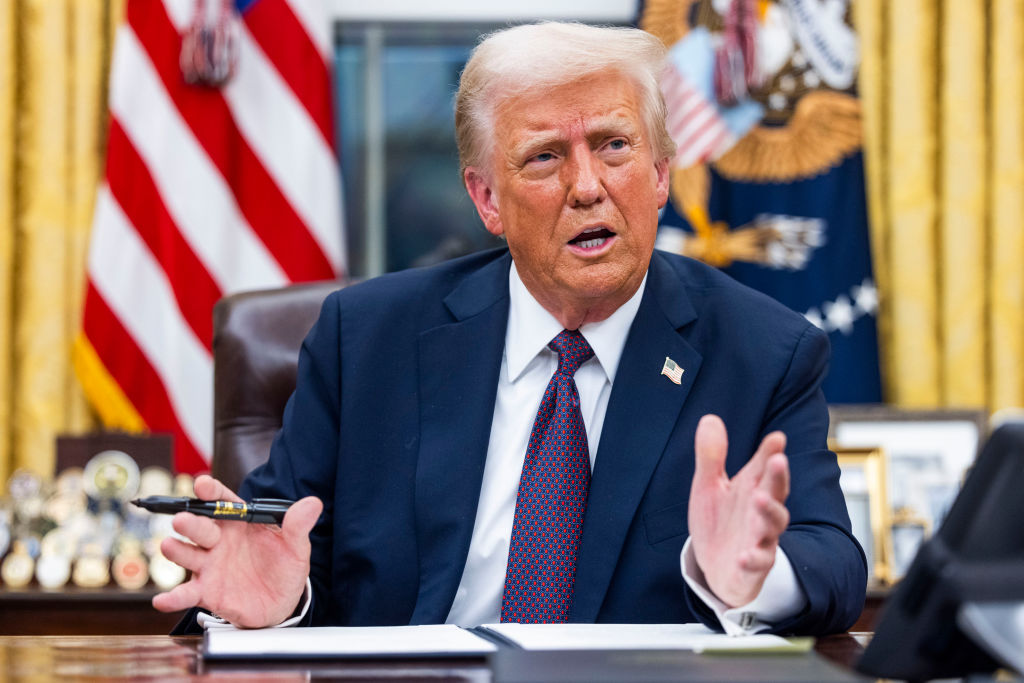
After his inauguration on January 20, U.S. President Donald Trump told reporters that his administration is preparing to impose 25% tariffs on Mexico and Canada, saying, “I think we’ll do it Feb. 1.”
Trump said the tariffs would target these two countries because they allow “mass numbers of people to come in and fentanyl to come in.” He stated that his administration is meanwhile considering a universal tariff on all imports, regardless of country of origin.
Trump also signed an executive order that commissions a broad review of U.S. trade policy and mandates that the secretaries of the Commerce and Treasury Departments and the U.S. Trade Representative analyze how to create an “External Revenue Service” for collecting customs and duties tied to trade.
AQ asked analysts to share their reactions and perspectives.

Sergio A. Luna
Grupo Financiero Mifel’s chief economist, Mexico City
President Trump’s opening remarks and the first raft of executive orders confirm a conflictive, transactional relationship with Mexico. The release of the America First Trade Policy document suggests that the Trump administration’s mercantilist approach is real, and that tariffs and trade disputes should be expected.
I believe some measures, like the tariffs on Mexico and Canada, were not enacted on day one because the Trump team is still trying to figure out how to reconcile disparate policy goals. For instance, it seems Trump prioritizes increasing fiscal revenue via tariffs, hence the creation of the External Revenue Service (ERS). But this assumes that tariffs will not deter imports—i.e., that demand for imports is price inelastic.
Moreover, they will have an inflationary impact; the ERS would end up taxing Americans. The alternative is to accept a significant appreciation of the USD, but “America First” suggests this would be rejected, too. What’s left? Heterodox trade policies, perhaps including some form of Voluntary Export Restraints (VERs) that the U.S. used back in the 80s, but with price rather than quantity targets. Solving this game of whack-a-mole on the U.S. trade policy would lead to a lot of uncertainty and—very likely—bad outcomes.
However, I’m more worried about border policy and migration. Markets may not for the moment know how to react to changes on these fronts, but I believe they are even more relevant in the medium term than tariffs. Stiffening border controls, for instance, could disrupt the auto sector’s regional value chains more than tariffs, hurting one of the sectors Trump cares about the most. Likewise, his designation of cartels as terrorist organizations significantly increases transactional risks for businesses in Mexico at a delicate time given the major judiciary reform underway in the country. Both of these factors will increase contractual costs in Mexico.
Moreover, unilateral action on the cartels—rather than binational approaches such as the Mérida Initiative—will limit effective action. The U.S. and Mexico share the goal of addressing the scourge of organized crime, but such moves create an adversarial atmosphere that will limit the Sheinbaum administration’s room for maneuver to cooperate with Trump on any front. The Mexican government’s assessment of Trump’s first day in office is likely that the situation is much more complicated than expected. The scrambling for sympathetic ears within the Trump administration is probably in full swing.

Antonio Ortiz-Mena
CEO of AOM Advisors, Chair of the Mexican Foreign Trade Council (COMCE)’s USMCA Committee, and adjunct professor at Georgetown University
President Trump has said his push on tariffs has several objectives: fostering fair trade, reducing the U.S. trade deficit, generating additional revenue through the “External Revenue Service,” revitalizing U.S. manufacturing, and pressuring Canada and Mexico to address undocumented migration and fentanyl trafficking. On January 20, he signed an executive order on the “America First Trade Policy,” mandating a broad review of trade and related issues. It should come as no surprise when tariffs and other trade restrictions are imposed on exports from a range of countries.
Trump’s threat to impose 25% tariffs on February 1 may be an attempt to force Canada and Mexico to curb undocumented migration and fentanyl trafficking, but using threats of tariffs as leverage in these areas risks unintended consequences.
Canada and Mexico prefer to keep security and trade negotiations separate because challenges in one area can hurt cooperation in others. Domestic politics influence U.S. trade policy, and it is no different for Canada and Mexico. It will be politically difficult for their governments to simply acquiesce to greater cooperation on migration and fentanyl due to threats or the actual imposition of tariffs, and it will be politically untenable for them to abstain from carefully targeted retaliation should the U.S. impose them.
Moreover, the U.S. wants privileged market access for the exports of its workers, farmers, and ranchers. And they already have that in Mexico and Canada, which are the #1 and #2 trade partners of the U.S., respectively. By the end of 2024, they were the top two markets for U.S. agricultural exports, surpassing China. Unilateral U.S. actions could put some of that access at risk.
The U.S., Canada, and Mexico have experienced negotiators who can help the three neighbors collaborate to address undocumented migration and fentanyl trafficking while ensuring that USMCA trade rules are respected and that workers in all three countries benefit. The stakes are high, but negotiations can still result in constructive agreements on both trade and non-trade issues.

Ernesto Revilla
Managing director and head of Latin American economics at Citigroup
While President Trump did not explicitly mention tariffs against Mexico in his inaugural speech, a few hours later, he reiterated his plan to enact at a rate of 25% by February 1 on the issues of fentanyl and migration. The Mexican peso, which had reacted favorably to the exclusion of tariffs in the formal speech, depreciated after the latter remarks. This episode stresses the fact that the U.S.-Mexico relationship is going to be noisier, with concomitant implications for Mexico’s risk premium and volatility.
The market and its analysts might still believe that Trump’s stated tariff plans are designed primarily to gain leverage in negotiations on migration and drug flows, particularly as we ramp up toward the planned revision of USMCA in 2026. However, there is a risk that tariffs might be implemented, even if at lower rates and limited to specific products or sectors. There has been a paradigm shift in how the U.S. thinks about trade, and both the market establishment and Mexico’s political establishment might not have fully digested this as they appeal to rationality and point out costs to the U.S. consumer.
For its part, Mexico does not seem fully engaged yet. President Claudia Sheinbaum did not meet with Trump when he was President-elect, bucking tradition. The Sheinbaum administration’s recent presentations indicate that it’s leaning on charts showing that U.S. fentanyl deaths and border crossings are coming down. The idea that this data will compel Trump to dial down his threats seems optimistic, particularly because it seems that he’s after clear concessions and sellable political wins.
While a 25% blanket tariff on Mexico—which would, in effect, void the USMCA—is still not the base scenario, it’s clear that the U.S. is moving toward a higher weighted average tariff against trading partners. Flexible currencies remain the best shock absorber in such a scenario. If tariffs were to be imposed, the depreciation of the Mexican peso would offset some of the blow, but GDP, investment, and consumption would all decline.
Mexico has strong fundamentals and some flexibility in its macro, financial, regulatory, and foreign policies. Moreover, it can still leverage its geographical and competitive advantage as part of the solution for the U.S. in its decoupling from China. However, this would require a reliably business-friendly institutional environment, as well as a very proactive strategic approach in response to the uncertainty coming from the U.S.

Heidi Jane Smith
Research professor of economics at Universidad Iberoamericana, Mexico City
Implementing a 25% tariff on Mexico is President Trump’s negotiation strategy aimed at addressing issues related to migration, dismantling drug cartels, securing the southern border and advancing the administration’s broader agenda. However, this approach can also have significant repercussions for the U.S. economy, particularly because it could drive up consumer prices. The proposal strikes a blow to future investments from abroad, the U.S. credit rating, the trade balance, and integrated production chains, potentially hindering growth expectations as the domestic markets struggle to absorb the excess supply. American consumers will likely feel the pinch, facing higher costs for groceries, fuel, energy, transportation, and other retail goods in the mid-term.
In the shorter term, prices will fluctuate as they set a reliable pricing scheme for goods and services produced within the U.S. Alternatively, the impact of tariffs on consumers could be mitigated if the exporting country absorbs part of the burden by reducing its prices for U.S. imports. China employed this approach during Trump’s first term, expanding into Mexico using nearshoring strategies. Unless the U.S. acknowledges Mexico’s strategic importance for trade, production and export, particularly concerning key port cities like Guaymas, Manzanillo or Coatzacoalcos, it risks losing more competitive ground to China in attracting investment opportunities within Mexican territory. This oversight could position the U.S. in direct competition with China’s new port in Chancay, Peru.
The long-term effects of these tariffs, if implemented, could further impact the U.S. As markets adjust, the U.S. may face the risk of capital flight if land and labor resources are not adequately adjusted. To mitigate these risks, it is essential to negotiate improved terms that foster a more substantial labor supply (including migration with appropriate visa allocations), ensuring robust support for the buying and selling of U.S. goods and services both domestically and abroad.





